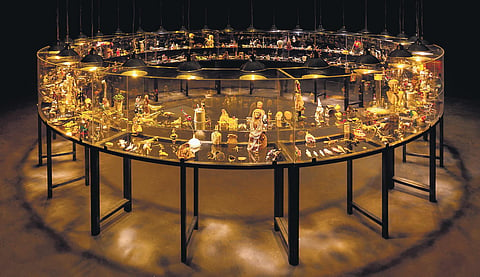

To declutter, the influential Japanese organising consultant Marie Kondo advises to only keep items that “spark joy”. While an object can be thrown out of the house, can the sentimentality be taken out of it? Hundreds of such discarded things—an old book, figurines, toys, jewellery and more—find place in Mithu Sen’s Museum of Unbelongings (MoU). Created between 2011 and 2018, the installation features gifted, found and “pre-loved” articles from her personal collection, and till date has six versions.
“Every time, it’s a new MoU. There are new objects, a new composition and narrative, and it changes according to the geography, location and politics,” says the Delhi-based artist. The latest is part of her ongoing solo, mOthertongue—a mid-career retrospective featuring 41 works across mediums such as drawings, paintings, installations and more—at the Australian Centre for Contemporary Art (ACCA), Melbourne.
In the MoU at ACCA, for instance, she has added a boomerang, which has historically been a symbol of the country’s aboriginal community. There is also a kangaroo soft toy made in traditional Indonesian crossstitch embroidery. While Australia is home to nearly 90,000 people from the southeast Asian nation, it also issued a ban, nine years ago, on refugees registered with UNHCR in the country after July 1, 2014. The seemingly insignificant object, then, brings to light the humanitarian crisis. “MoU questions these politics, but in a strange unworldly way,” she says, adding, “The objects are unbelongings; they don’t belong to anyone. But, with the work, I give value to them, which in turn also talks about the politics of value-creation and consumption.”
The use of un- as a prefix is a distinctive element of Sen’s two-decade-long practice. She uses it as
a “linguistic tool, a narrative trope and a strategy all at once”. But contrary to what one would assume,
its purpose is not to negate or oppose. “I see ‘un-’ as a method in carrying out unsettlements, beginning first and foremost with the confusion of language it can create for the audience,” she says. Over the years, the 52-year-old has been adding the prefix to terms that capture her fancy, to create a glossary of 80,000 words. She uses them as part of her art to express her innermost rumblings. A quick glance at her website reveals what they are—Unlingual anarchy, Unmonolith identity, Untaboo sexuality and Unencounter capitalism.
All these ideas come together in the 2018 installation UnMYthU: UnKIND(s) Alternatives,
a series of five large-scale anatomical labelled drawings placed in light boxes, with a performative element. “This is the third time I am showing this, but it evolves with every exhibition, as our experiences change,” she says. Among the most recent ideas explored in the work at ACCA is AI and bot-culture. “The series explores the in-betweenness, which is how I see life. There is nothing definitive. It’s always a process, a kind of a becoming. It makes you realise that something is always happening that you cannot define or explain,” she says.
In the work, she uses kozo paper, a handmade Japanese paper, which is extremely thin, but also layered and strong. Its qualities allow the artist to “camouflage” topics that are considered “forbidden”—sexuality, fascism etc.—on the other side, which become visible when the lights turn on.
Sen’s practice spans across mediums. There is drawing, performance, painting and sculpture. When asked if she prefers one over others, she says, “My preferred medium is life itself and all artworks are by-products,” and adds, “I approach work conceptually through research, play and humour, and attune it with the materiality of a form. This perpetual shapeshifting helps me work in relation to the changing world and allows me to maintain my agency.”
She asserts this control most evocatively in the performative video installation, titled How to be a SUCKcessful artist, using language as a tool. The satirical work features the artist speaking gibberish, with a list of universally marginalising factors—gender, geography, economics and more—scrolling on a screen behind her. One of them reads, “Capitalise anti-capitalism”.
The artist’s attempts to question and disrupt status quo is evident in the very title of the show, as the small ‘m’ redirects the viewers’ focus to ‘othertongue’. The idea is to “dismantle the hierarchical baggage of languages,” she says. For Sen, mother tongue is not just one’s native language, but a way of communication that comes naturally. Hers is poetry. Born to a poet mother, she rhymed before she could write. “It was to put a premium on immediacy and feeling. The other tongues are those with elaborate grammars and syntaxes, making expression a herculean task.” She adds, “It is here that I see mothering and othering at work—mothering nurtures, othering creates barriers, whether in the domain of language, or elsewhere.”